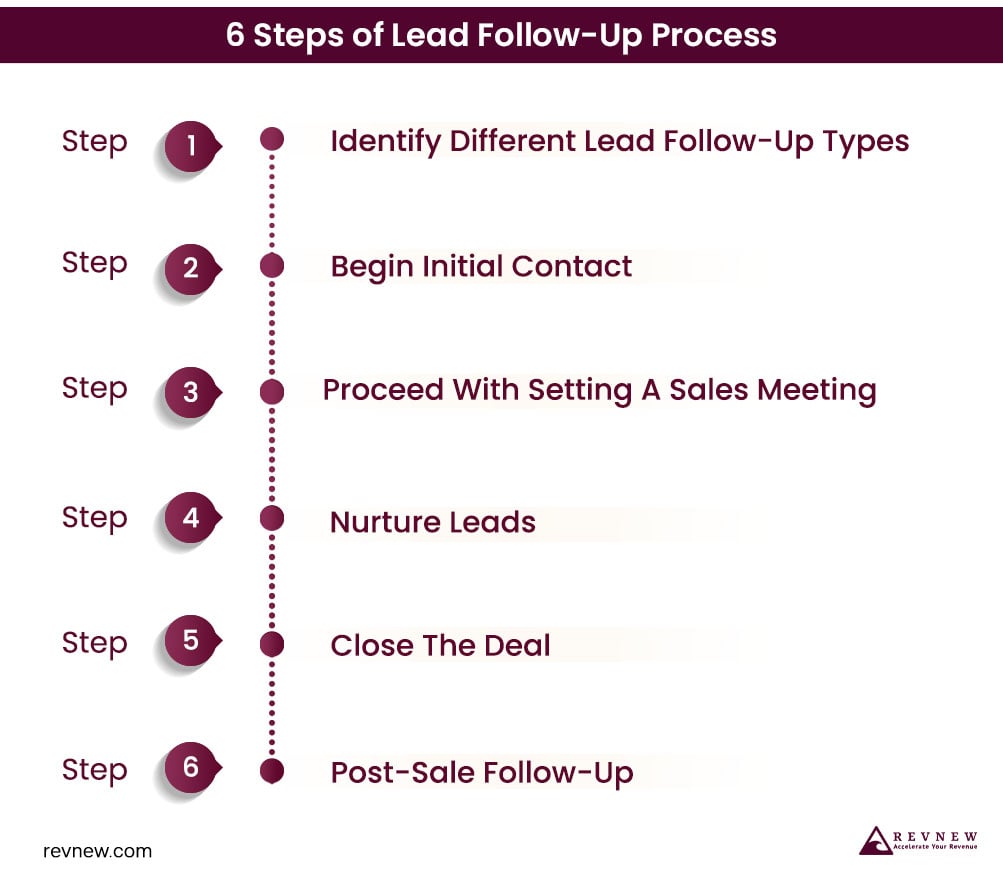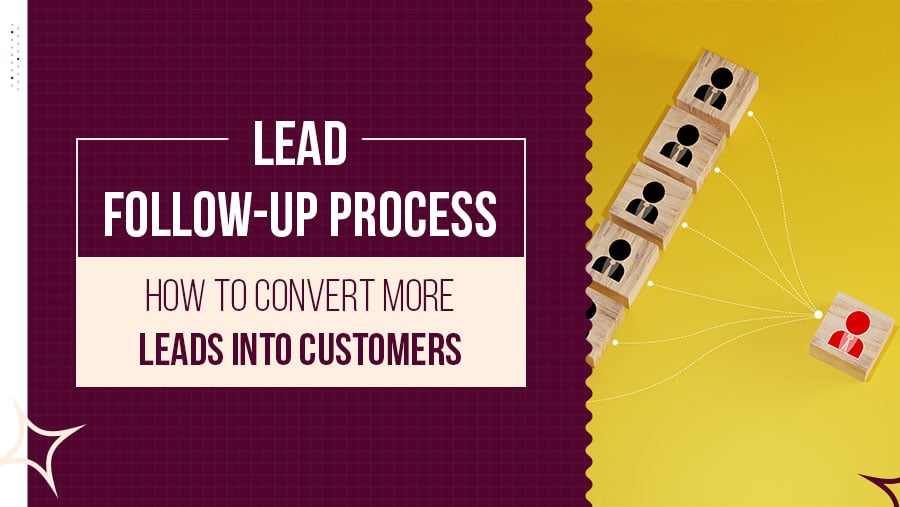
Lead Follow-Up Process: How to Convert More Leads into Customers
You must have heard the saying that follow-up brings fortune. It couldn't be more true when it comes to sales. Following up with leads is a crucial component of the sales process that can make the difference between closing a deal and losing a potential customer.
But how do you effectively follow up with leads without being pushy or annoying?
In this guide, we will explore the lead follow-up process and provide you with tips and best practices for nurturing leads, building relationships, and closing deals. So, let us get started.
6 Steps of Lead follow-up process
An effective lead follow-up process involves the below given six steps. Check them out here:
1. Identify Different Lead Follow-Up Types
You should know the difference between the three main types of leads that you'll be following:- Suspects- These are the prospects within your target market. With suspects, you aim to attract their attention and encourage them to contact you on your website or visit your store/office.
- Prospects- These include prospects who have expressed interest but have yet to make a purchase. Your goal for prospects is to persuade them to make their first purchase and become customers.
- Customers- These prospects are the ones who have already made a purchase. Finally, with customers, your focus should be building a solid relationship, encouraging repeat business, and generating referrals.
2. Begin Initial Contact
When reaching out to a lead for the first time, it's important to make a good impression and establish a positive relationship. Here are some tips for beginning your initial contact:
- Acknowledge the Lead's Response- If a lead responds to your outreach attempts and asks related queries, always tell them you received them.
- Case studies
- Testimonials or anything else that can help the lead make an informed decision
This simple step can help build trust and let the lead know their message was not lost in the shuffle.
- Thank The Lead For Their interest in your product/service- 75% of consumers prefer companies that offer rewards. Express your gratitude for the lead's interest in it. You can do this by offering rewards/coupons to leads.
It shows that you value them and helps to establish a foundation for positive and beneficial future communications.
3. Proceed With Setting a Sales Meeting
After your initial contact with a lead, continuing the conversation and nurturing the relationship is important. It'll help you schedule sales meetings quickly. Here are some tips for proceeding with your follow-up communication:
- Confirm The Lead's Interest Level- Before you go all in to follow-up on a particular lead, take the opportunity to gauge their interest level. Here's how you can do this:
- Pay attention to their responsiveness and engagement in communication.
- Assess their level of curiosity and ask open-ended questions to gauge their interest.
- Observe if they actively seek more information about your product or service.
- Determine if they express a clear need or problem that your product can solve.
- Notice if they show interest in exploring specific features or benefits.
- Assess if they inquire about pricing, implementation, or next steps.
Additionally, address any concerns or questions they may have. Doing so builds trust and credibility and shows that you are genuinely interested in helping them.
- Contact The Lead Promptly- Chances of having meaningful conversations with prospects increase by 7% when you follow up leads within 1 hour rather than taking 60 minutes.
It's crucial to promptly follow up with the lead to maintain their interest and show commitment to their needs.
So, respond promptly to any queries or questions leads may have. Also, let them know that you are available to provide further information.
- Schedule A Sales Meeting- If the lead expresses continued interest in your product or service, schedule a sales meeting to discuss further. It can include a demo, consultation, or any other relevant discussion to help the lead make an informed decision.
4. Nurture Leads
If you didn't close the deal in the first sales meeting, nurturing leads becomes critical to make it happen. Here are some tips for effectively nurturing leads:
- Personalized Communication- When it comes to nurturing leads, one size does not fit all. Personalizing communication and tailoring it to the lead's needs and interests can help you to stand out from the competition and build stronger relationships.
- Referencing specific pain points or challenges the lead faces
- Highlighting how your product or service can address their unique needs.
You need to demonstrate you understand their situation and are committed to finding the right solution.
- Provide Additional Resources Or Materials- One effective way to nurture leads is by providing additional resources or materials that may interest them. It could include:
- Industry reports
- White papers
- Case studies
Your additional resources should demonstrate how your product or service can benefit leads.
- Send Periodic Follow-up Emails- Staying top-of-mind is essential to nurturing leads. Sending periodic follow-up emails or newsletters can help you stay connected with potential clients and remind them of your value.
Studies say when you send emails during follow-up phone calls, there's a 16% higher chance of engaging with leads one-on-one.
Research also suggests that 90% of the time, interested recipients reply to a business email within two days. Thus, you must do your best to create an appealing email. Some of the best practices for follow-up emails you must use are:
- Add a compelling subject line.
- Use a positive tone while crafting your email. It's found to increase response rates by 10-15% than a neutral tone.
- Keep the message simple, short, and clear.
- Ask direct questions to boost their chances of giving a desired response to your email. Such as:
- Can we schedule a time that suits your schedule in the next week or two?
- Would it be possible to find some time in the upcoming weeks to discuss your development goals?
- Does [time and date] sound good to you for our meeting?
5. Close The Deal
Closing the deal with a lead is the final step in the lead follow-up sales process. Therefore, it's crucial to approach this stage with a focus on meeting the lead's needs and securing their business. Here are some tips for closing the deal:
- Present A Proposal/quote Aligning With The Lead's Needs And Budget- Once you determine the lead's readiness to move forward, it's time to present a proposal or quote that meets their needs and budget.
- Lead's pain points
- goals
- Priorities
Plus, it should highlight the value of your product or service in addressing these factors.
- Address Any Remaining Concerns/Objections Of Leads- It's common for leads to have questions or concerns before making a final decision. So, it's essential to be prepared to address these objections.
- Addressing pricing concerns
- Offering a trial or demo to alleviate any doubts or uncertainties
6. Post-Sale Follow-Up
After closing a sale, it's crucial to continue building the relationship with the customer to ensure their satisfaction and foster future business opportunities. Here are some tips for post-sale follow-up:
- Thank the customer for their business- After the sale, it's crucial to confirm the purchase details and express your gratitude for the customer's business. It may include sending a personalized email or note or making a phone call to thank the customer.
- Provide Information On The Next Steps- Depending on the product or service, there may be additional steps or information that the customer needs to be aware of.
This information clearly and concisely can alleviate any confusion or uncertainty and ensure a smooth and successful post-sale process.
- Continue nurturing and look for upsell/cross-sell opportunities- Even after the sale is completed, it's essential to continue building the relationship with the customer and looking for opportunities to add value.
- Offering additional products or services that complement their purchase.
- Providing ongoing support and assistance to ensure their satisfaction and loyalty.

Conclusion
The lead follow-up process is crucial to any successful sales strategy. From acknowledging the lead to nurturing them with personalized communication and valuable resources, each step is vital to building strong customer relationships and closing deals.
Thus, by being persistent yet respectful and focusing on the needs and interests of the lead, you can increase their chances of converting leads into customers. So, invest time and effort into the lead follow-up to set yourself up for long-term success and profitability.





